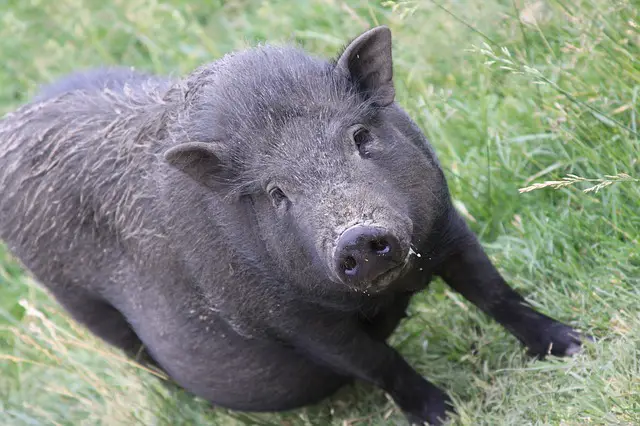Pigs can still be an unknown creature to many of us and thus we wonder about many things regarding them. Many of us are curious and that is why we researched thoroughly to satisfy our curiosities!
So when do pigs stop growing? Pigs stop growing around 2 to 3 years of age. Their growth will slow down as soon as they reach their sexually matured age of six months old.
We want new and potential owners to be set with proper expectations that some pigs can grow twice their current size because their growth can slow down later on!
Pigs are also made up with diverse genetics which means they do not always stick to their breed’s expected standards.
Some pigs may stay small, some may grow larger than expected.
A pig’s growth can become unpredictable and that is why we want everyone to be aware of the possibilities in order not to be disappointed. Being properly informed will also help owners prepare for a pig’s growth.
There are several factors that can affect a pig’s growth. It can either stunt growth or accelerate the growth.
Pigs have certain breeds that have faster growth rates than the others but normally, six months is just about right for many farmers and owners.
Some breeds also grow slower compared to other breeds which also resulted in a decline of population.
A pig’s size and weight can also heavily depend on their breed’s standard traits. However, there are times when a pig grows out of their breed’s expectations.
Depending on how a pig is raised, their growth can also differ. There are times when pigs will stop growing due to unhealthy living conditions but when pigs are kept under a healthy environment, they tend to follow a stable growth routine.

Factors that affect a pig’s growth
Just like people, there are also factors that can affect a pig’s growth. Below, we will explain these factors in detail in order to further understand pigs and their growth.
- Genetics
- Diet
- Health
- Environment
- Selective Breeding
Genetics
Genetics play the most natural part and truly affects growth more than anything else. A pig’s genetics can be diverse as many breeds have been naturally crossbred after many years of domestication.
Diet
A healthy and balanced diet can help accelerates growth in some pigs and can be really useful for certain farmers. Just like with people, a proper diet with pigs works wonders.
Health
There are certain cases when pigs can be born with medical complications and may lead to a delayed growth. It is normal and can happen in other animals including people too.
Environment
A clean and healthy environment will help enrich a pig’s overall health and can definitely boost or support a pig’s growth.
Selective Breeding
This is the act of intentionally manipulating genetics in order to produce a favored new breed. Selective breeding may have a bad reputation for some, but there are good breeders out there.
How fast pigs can grow
On an average, most pigs can grow and become fully matured at about six months of age! But then again, just like what was mentioned earlier… there are specific breeds that can grow faster or slower than the others.
Fastest Growing Breeds of Pigs
Please note that this list is not following a specific order but all of these pigs fall under the category of fast growing.
- Berkshire pigs
- Poland China pigs
- Duroc pigs
- Hampshire pigs
- British Landrace pigs
- Spotted pigs
- Yorkshire pigs
- Chester White pigs
Special breed: Meishan pigs — can become sexually matured at two to three months of age.
Meishan pigs are a Chinese breed that is often black in color with a wrinkly face similar to the popular Shar Pei dog breed which is also from China.
Meishan pigs also have large drooping ears, a trait that many owners love and look for. The drooping ears just make them a lot cuter, in the eyes of many.
The average body weight of a mature Meishan pig is 61 kg (134 pounds) and their average height for an adult Meishan pig can grow up to 22 inches tall (57.8 cm) and if measured around the chest it can be 39 inches (100 cm)
You can learn more about the mentioned breeds in this post by clicking the blue texts on their names.
The Growth Cycle of a Pig
After learning about their growth, it is only natural for people to wonder about the normal life cycle of a pig. Market pigs or pet pigs, we will explain it all in here.
Pet Pigs — Life Cycle
Often times, pet owners prefer to adopt weaned piglets. Piglets are usually weaned at around 21 days of age but it can still depend on the breeder.
Weaning means the process of turning piglets independent from their mother’s nursing and enabling them to eat on their own.
This way, they can be easier to care for and be raised without their mothers.
Starting from a young piglet, owners will begin to teach piglets their name and since pigs are intelligent animals, they can learn their names within two weeks of age meaning owners will only need another two weeks to learn a new name.
After that, the pet piglet should be able to adjust to an indoor lifestyle or backyard lifestyle if the owner sets it up for them.
Pigs grow and become matured at 6 months of age therefore if the owner is not planning to breed their pet pigs, they should spay and neuter their pet pigs.
Luckily for pet pigs, there is no limitation to their life cycle and they will be able to continue enjoying life as usual on a daily basis after settling down with their loving homes unlike farm pigs.
Farm Pigs / Market Pigs — Life Cycle
Pig pregnancy takes up to 3 months
and a few more days. Pregnant pigs will be moved to a special area in order to
give birth.
On an average, pigs are expected to give birth to 10 to 12 piglets but this can
differ depending on a pig’s breed.
Upon giving birth, piglets will be weaned as early as 21 days of age.
When piglets are successfully weaned, they are then moved to a nursery with
other piglets with a properly controlled temperature in order to monitor the
sensitive health of a young pig.
Young pigs can grow up to 27 kilos at most but it can still depend on their
breed.
Everything is set out smoothly as soon as a piglet has been properly weaned as
they will just continue to be raised and fed by farmers to grow them as they
wish.
Commonly, as soon as the pigs reach six months of age, they are big enough for
the market.
Related Questions
- What is the largest breed of pig in the world?
The largest known breed of pig is the Giant Forest Hog.
If you are familiar with Pumbaa of the popular Disney film, “The Lion King“, the warthog and Giant Forest Hog are similar in terms of appearance.
The Giant Forest Hog inhabits areas around Africa and some places in the West. They are wild pigs and may tend to be aggressive towards intruders.
It is best not to threaten or intimidate a Giant Forest Hog as they are capable of mauling a human with their tusks and leaving grave injuries.
Despite their large size, they are still considered prey animals and still in hunted by predators in the wild. They may not live as long as a domestic pig due to their mortality rate in the wild.
- What is the smallest breed of pig?
The Pygmy hog is the smallest known breed of pig but it is a wild pig and not suitable for domestication. It is also critically endangered as of today and requires utmost protection from any possible harm.
Pygmy hogs used to inhabit the areas of India, Bhutan and Nepal but now that they are endangered, they can only be found in India.
They are about 55 cm to 71 cm (21.5 inches to 28 inches) long and can stand at 20 cm to 30 cm (8 inches to 12 in).
Their tail length is 2.5 cm (0.98 inches).
They weigh between 6.6 kg to 11.8 kg (15 lb to 26 lb).
A pygmy hog’s skin color is dark brownish black and the hair is also dark. Their piglets are born grayish-pink that eventually turns brown with yellow stripes along the body length.
Their heads are sharply tapered and they also have a slight crest of hair on their foreheads and on the back of their necks.
Adult male pygmy hogs have upper canines visible on the sides of their mouths.
The average lifespan of a Pygmy hog is 4 to 8 years and become sexually mature at around one to two years old.
- What are the breeds of small pigs?
There are still many small breeds of pigs and we listed the most common or popularly known ones for you to check.
Not only are they common, they are
popular for their friendly characteristics!
One may think that they are all similar, but each breed could have their own
unique traits and personalities. Owning any kind of pet is a huge
responsibility and requires commitment.
Before deciding you want to adopt or buy a pig, it’s important to consider your
compatibility with them.

